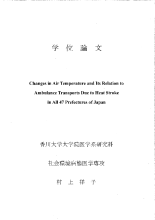Changes in air temperature and its relation to ambulance transports due to heat stroke in all 47 prefectures of Japan
この論文にアクセスする
著者
書誌事項
- タイトル
-
Changes in air temperature and its relation to ambulance transports due to heat stroke in all 47 prefectures of Japan
- 著者名
-
村上, 祥子
- 学位授与大学
-
香川大学
- 取得学位
-
博士(医学)
- 学位授与番号
-
甲第587号
- 学位授与年月日
-
2014-03-24
注記・抄録
ObjectivesChanges in air temperature and its relation to ambulance transports due to heat stroke in all 47 prefectures, in Japan were evaluated.
MethodsData on air temperature were obtained from the Japanese Meteorological Agency. Data on ambulance transports due to heat stroke was directly obtained from the Fire and Disaster Management Agency, Japan. We also used the number of deaths due to heat stroke from the Ministry of Health, Labour and Welfare, Japan, and population data from the Ministry of Internal Affairs and Communications. Chronological changes in parameters of air temperature were analyzed. In addition, the relation between air temperature and ambulance transports due to heat stroke in August 2010 was also evaluated by using an ecological study.
ResultsPositive and significant changes in the parameters of air temperature that is, the mean air temperature, mean of the highest air temperature, and mean of the lowest air temperature were noted in all 47 prefectures. In addition, changes in air temperature were accelerated when adjusted for observation years. Ambulance transports due to heat stroke was significantly correlated with air temperature in the ecological study. The highest air temperature was significantly linked to ambulance transports due to heat stroke, especially in elderly subjects.
ConclusionsGlobal warming was demonstrated in all 47 prefectures in Japan. In addition, the higher air temperature was closely associated with higher ambulance transports due to heat stroke in Japan.
Objectives Changes in air temperature and its relation to ambulance transports due to heat stroke in all 47 prefectures, in Japan were evaluated.
Methods Data on air temperature were obtained from the Japanese Meteorological Agency. Data on ambulance transports due to heat stroke was directly obtained from the Fire and Disaster Management Agency, Japan. We also used the number of deaths due to heat stroke from the Ministry of Health, Labour and Welfare, Japan, and population data from the Ministry of Internal Affairs and Communications. Chronological changes in parameters of air temperature were analyzed. In addition, the relation between air temperature and ambulance transports due to heat stroke in August 2010 was also evaluated by using an ecological study.
Results Positive and significant changes in the parameters of air temperature that is, the mean air temperature, mean of the highest air temperature, and mean of the lowest air temperature were noted in all 47 prefectures. In addition, changes in air temperature were accelerated when adjusted for observation years. Ambulance transports due to heat stroke was significantly correlated with air temperature in the ecological study. The highest air temperature was significantly linked to ambulance transports due to heat stroke, especially in elderly subjects.
Conclusions Global warming was demonstrated in all 47 prefectures in Japan. In addition, the higher air temperature was closely associated with higher ambulance transports due to heat stroke in Japan.

